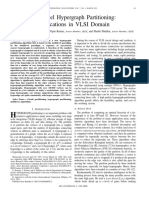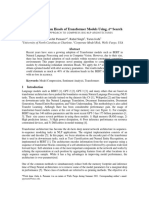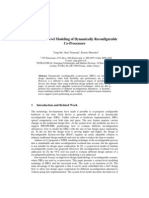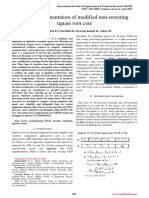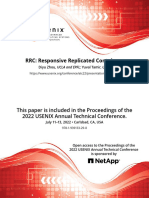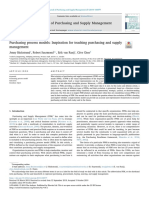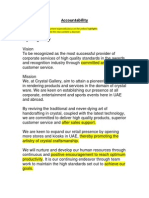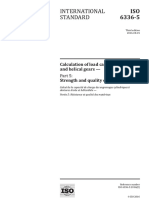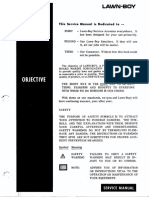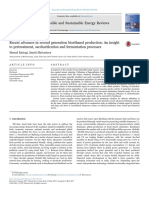Professional Documents
Culture Documents
Design of Efficient Serial Divider Using HAN CARLSON Adder
Copyright
Available Formats
Share this document
Did you find this document useful?
Is this content inappropriate?
Report this DocumentCopyright:
Available Formats
Design of Efficient Serial Divider Using HAN CARLSON Adder
Copyright:
Available Formats
Volume 3, Issue 11, November – 2018 International Journal of Innovative Science and Research Technology
ISSN No:-2456-2165
Design of Efficient Serial Divider Using HAN
CARLSON Adder
Dr B. Senthilkumar, R. Gowrishankar
Professor, Department of ECE
KIT- Kalaignarkarunanidhi Institute of Technology
Coimbatore, Tamilnadu, India – 641402
Abstract:- Important block of a central processing unit iteration. Intel Pentium-4 Processor makes use of SRT
in any computing system is Arithmetic and Logic Unit division [1] and [6]. Division operation consumes more time
(ALU). Among all the arithmetic operations, division is when compared to addition, subtraction and multiplication
considered to be more complicated and it completes [2] and [3]. Fast division method can be used but there is
after several cycles of time. Latency is increased because complexity in the structure when compared to the slow
of the clock cycles. It is frequently utilized in the areas of division. Thus an efficient algorithm which can improve the
signal and image processing applications. This work efficiency should be followed.
describes the architecture of a serial divider in
combination with the influence of Han Carlson adder. II. TYPES OF EXISTING DIVISION
Adder along with the non-restoring algorithm has been ALGORITHMS
tested for the design of divider in the DADENCE
platform. And found 48.67% reduction in delay over the Many algorithms used for serial division. Decimal
existing method. division uses the traditional method which done normally i.e.
the use of pencil and paper method [6]. The iterative process
Keywords:- Cadence, Han Carlson Adder, Serial divider, of the subtraction and shifting operation is carried out for
Non Restoring Algorithm, Delay. certain steps and hence called digit recurrence division
algorithm [6]. In the digit recurrence algorithm, single
iteration calculates one bit of the quotient. Partial remainder
I. INTRODUCTION
which is obtained by shifting is compared with multiples of
the divisor for determining quotient bit. The control unit of
Division operation is mainly used in scientific
this recurrence algorithm contains the Adder/subtractor
computation of image and digital signal processing. It can
modules which makes implementation of the algorithm easy
be accomplished either by serial division or parallel
and high level of accuracy. There occurs cerain disadvantage
division. Serial division is slow when compared to parallel
like more timing complexity due to this algorithm, when
division but its structure is very simple. Parallel division is
compared with multiplicative division algorithm [4] and [6].
fast when compared to the former one but its structure is very
complex. Division algorithm falls into two main categories,
There are three types of digit recurrence algorithm like
slow division and fast division, slow division includes
restoring, non- restoring and SRT [6]. For multiplicative
restoring and non-restoring division, whereas fast division
type of division algorithm, iteration is functional which uses
methods include Newton Raphson and Goldschmidt method
convergence techniques, starting from initial estimation till
of division [7].
the determination of quotient with required accuracy and
SRT is used. This algorithm leads to high performance
In conventional method of processing, digital division
when compared to the existing recurrence division
operation performs subtracting the divider from a reference
algorithm. The demerits of this algorithm are that it has
number, referred to as a current number which normally
complex steps and it requires more number of computations
requires that the divider be added back to the current
required to get the final remainder. This type of division is
number depends on the result of the subtraction stage. In
possibly seen in commercial applications like
non-restoring method the selection of either addition or
microprocessors and mainframe computers [3] and [4].
subtraction is carried out in the next computation stage [7].
Another method which is also a functional iteration based
Hence, the implementation of above requirement needs not only logic it
algorithm is called Newton-Raphson method. Gold
also needs large circuitry. Due to the above this a pretty good
Schimdt’s algorithm is the another algorithm for functional
amount of logic and related circuitry are required to
iteration where both numerator and denominator are
implement restoring and non-restoring division algorithms.
multiplied with the same number and thus the fractional
Digital recurrence is the simple and widely implemented
class of division algorithm. The most common value remains same.
implementation of digit recurrence division in modern
microprocessors is division from the initials of Sweeney (S),
Robertson (R) and Tocher (T) named SRT, who developed
the algorithm independently at approximately the same time.
SRT division uses subtraction as the fundamental operator
in order to have a fixed number of quotient bits in each
IJISRT18NV364 www.ijisrt.com 661
Volume 3, Issue 11, November – 2018 International Journal of Innovative Science and Research Technology
ISSN No:-2456-2165
III. NON RESTORING SERIAL DIVISION
ALGORITHM
Digit recurrence algorithm is the most common
algorithm though there were many literatures about several
division algorithms. This algorithm is again divided into
SRT type [6], restoring and non-restoring algorithm. The
Digit is the basic algorithm in which a non-restoring
algorithm is used to design a digital serial divider. Generally
recurrence algorithm mentioned above makes use of
iterative addition, subtraction and shifting operations in
order to perform the division process. Division based on
digital serial approach is simple and cheap whereas parallel
digital division approach has high costly and increased
complexity. Digital serial division is much slower when
compared to parallel approach. But the design of hardware is
complex and also parallel approach is expensive which
serves to be a tradeoff while choosing either serial approach
or digital parallel type of division [4].
Fig 1:- Structure of Han Carlson Adder
The digital serial division architecture based on the
non-restoring type of division technique is used. For this The architecture of serial division is implemented
particular digital design, the required remainder and using a 16-bit adder and subtractor unit. The adder and
corresponding quotients in non-restoring type of division is subtractor unit are the first and important blocks of serial
found by using the iterative process of add/subtract and shift divider. Its operation has been verified by giving suitable
[4]. Here the adder cell used is Han Carlson adder. The inputs.
adder cell is controlled by quotient determined in the
previous step in order to perform the addition or subtraction. VI. EXPERIMENTAL RESULTS
With the help of shift register, the partial remainder is shifted
to get the required output. Comparison of existing serial divider module and
proposed module in terms of delay is given in Table 1.
IV. EXISTING SYSTEM
Ripple carry adder (RCA) is used in the existing serial Delay of Existing System 55.28ns
division technique. RCA is the simplest type of adder [2]. It
Delay of Proposed System 26.904ns
consists of series of full adder till ‘n’ bits. RCA architecture
is simple to design and for more number of bits processing Table 1:- Comparison of Proposed System
this simple structure may take some time period to process.
The delay can be reduced if the structure of the RCA is
modified in the existing adder. By keeping this into
consideration the methods have been proposed for adders.
One of the suitable addition methods for the divider is Han
Carlson adder.
V. IMPLEMENTATION OF PROPOSED SYSTEM
Han Carlson adder along with non-restoring technique
is used in the proposed design of serial divider. It also
functions with the parallel prefix adder concept [1]. It has
black cells, gray cells and buffer. Black cell is the
combination of one OR gate and two AND gate. White cell
is the combination of OR and AND gate. Buffer gives
output value same as input value. Whereas it differs from
other adder and it can be utilized for large word sizes. On
comparing with other adders Han Carlson has low latency
[5]. VerilogHDL coding for the above logic has been done
and has also been tested by using CADENCE platform. The Fig 2:- Result of Han Carlson Adder
structure of Han Carlson adder is shown in fig.1.
IJISRT18NV364 www.ijisrt.com 662
Volume 3, Issue 11, November – 2018 International Journal of Innovative Science and Research Technology
ISSN No:-2456-2165
Communication Engineering (IJARECE), Volume 5,
Issue 2, pp. 226-230, February 2016.
[6]. R. Mishra, ‘An efficient VLSI architecture for a serial
divider’, Devices for Integrated Circuit (DevIC),
Kalyani, pp. 482-486, 2017.
[7]. Suyash Toro, Y.V. Avinash Patil, S.C. Chavan, D.S.
Bormane and Sushma Wadar, “Division operation
based on Vedic Mathematics”, IEEE International
Conference on Advances in Electronics,
Communication and Computer Technology
(ICAECCT), pp. 450-454, 2016.
Fig.3: Result of Proposed Divider
The simulated results have been given in Fig.2 and Fig
.3 for Han-Carlson and the Proposed Divider respectively.
VII. CONCLUSIONS
Arithmetic divider is the primary block of image and
signal processing applications. The proposed divider system
featured with Han Carlson adder and Non- Restoring
algorithm has been tested for many examples and found
satisfactory results with the delay reduction of 26.904 ns
which is 48.67% improvement in delay efficiency of the
proposed system over the existing system. Results have
been tested by using CADENCE platform.
REFERENCES
[1]. K.Swapna Gedam and P.Pravin Zode, “Parallel prefix
Han Carlson Adder”, International Journal of Research
in Engineering and Applied Sciences, Vol. 02, Issue 02,
July 2014.
[2]. Jasbir Kaur and Lalit Sood, “Comparison Between
Various Types of Adder Topologies” IJCST Vol. 6,
Issue 1, pp. 62–66, March 2015.
[3]. A.S. Prabhu, B. Naveena, K. Parimaladevi, M.
Samundeswari and P. Thilagavathy “Serial Divider
Using Modified GDI Technique”, International Journal
of Innovative Research in Electrical, Electronics,
Instrumentation and Control Engineering, Vol. 3, Issue
10, pp. 73-76, October 2015.
[4]. Jen-Shiun Chiang, Hung-Da Chung and Min-Show
Tsai,“Carry-Free Radix-2 Subtractive Division
Algorithm and Implementation of the Divider”,
Tamkang Journal ofScience and Engineering, Vol. 3,
No. 4, pp. 249-255, 2000.
[5]. K.Subha Jeyamala and B.S.Aswathy, “Performance
Enhancement of Han – Carlson Adder”, International
Journal of Advanced Research in Electronics and
IJISRT18NV364 www.ijisrt.com 663
You might also like
- FPGA Implementation of Fixed Point Integer Divider Using Iterative Array StructureDocument10 pagesFPGA Implementation of Fixed Point Integer Divider Using Iterative Array StructureerpublicationNo ratings yet
- Low Latency Floating-Point Division and Square Root UnitDocument14 pagesLow Latency Floating-Point Division and Square Root Unitpradipta.sarkarNo ratings yet
- Division Algorithms and ImplementationsDocument22 pagesDivision Algorithms and Implementationsamitpatel1991No ratings yet
- SRTDivision AlgorithmsDocument4 pagesSRTDivision AlgorithmsAsif KhanNo ratings yet
- Comparative Study of Scheduling Algorithms For Real Time EnvironmentDocument4 pagesComparative Study of Scheduling Algorithms For Real Time EnvironmentSreedhar NagavellyNo ratings yet
- Report On Research Paper: Improving of Quicksort Algorithm Performance by Sequential Thread or Parallel AlgorithmsDocument11 pagesReport On Research Paper: Improving of Quicksort Algorithm Performance by Sequential Thread or Parallel AlgorithmsvivekNo ratings yet
- 1 7 - VLSI V5 I2 001Document7 pages1 7 - VLSI V5 I2 001Mahreen KhanNo ratings yet
- 4175-Article Text-7672-1-10-20210430Document12 pages4175-Article Text-7672-1-10-20210430elektrik ve elektronikNo ratings yet
- Review On Word Length Optimization: Pandi G Sabareeswari, Bhuvaneswari S DR Manivannan SDocument4 pagesReview On Word Length Optimization: Pandi G Sabareeswari, Bhuvaneswari S DR Manivannan Sbhuvana_eeeNo ratings yet
- Function Unit Specialization Through Code AnalysisDocument4 pagesFunction Unit Specialization Through Code AnalysisdanbenyaminNo ratings yet
- Adaptive Approximation in Arithmetic Circuits A Low-Power Unsigned Divider DesignDocument6 pagesAdaptive Approximation in Arithmetic Circuits A Low-Power Unsigned Divider DesignShweta RaoNo ratings yet
- Determining The Number of Clusterssegments in Hierarchical ClustDocument9 pagesDetermining The Number of Clusterssegments in Hierarchical ClustFabian Isaac Mendoza FloresNo ratings yet
- Modified DA Based FIR Filter in Multirate DSP Systems On FPGADocument5 pagesModified DA Based FIR Filter in Multirate DSP Systems On FPGAEditor IJRITCCNo ratings yet
- 59 - VHDL MontgomeryDocument9 pages59 - VHDL MontgomeryhbhbdNo ratings yet
- Generating A Periodic Pattern For VLIWDocument18 pagesGenerating A Periodic Pattern For VLIWanon_817055971No ratings yet
- Design and Implementation of Sorting Algorithms Based On FPGADocument4 pagesDesign and Implementation of Sorting Algorithms Based On FPGAeviteNo ratings yet
- R2 - On Tolerating Faults in Naturally Redundant AlgorithmsDocument10 pagesR2 - On Tolerating Faults in Naturally Redundant AlgorithmsN EMNo ratings yet
- Unit-2 Temperature ControlDocument4 pagesUnit-2 Temperature ControlSakthi PeriasamyNo ratings yet
- Fast Combinational Architecture For A Vedic DividerDocument5 pagesFast Combinational Architecture For A Vedic DividerkopperundeviNo ratings yet
- Indic On Paper I EeeDocument5 pagesIndic On Paper I Eeeelektrik ve elektronikNo ratings yet
- Implementation of Non Restoring Interval Divider UnitDocument4 pagesImplementation of Non Restoring Interval Divider Unitsurendiran123No ratings yet
- HmetisDocument11 pagesHmetissriNo ratings yet
- Reduced Instruction Set Computers (RISC) : William Stallings, Computer Organization and Architecture, 9 EditionDocument24 pagesReduced Instruction Set Computers (RISC) : William Stallings, Computer Organization and Architecture, 9 EditionAnh NguyễnNo ratings yet
- Variation-Aware Low-Power Synthesis Methodology For Fixed-Point FIR FiltersDocument11 pagesVariation-Aware Low-Power Synthesis Methodology For Fixed-Point FIR FilterskishorechiyaNo ratings yet
- A Study On Rapidly-Growing Random TreesDocument3 pagesA Study On Rapidly-Growing Random TreeskfuScribdNo ratings yet
- SRT Division Architectures and ImplementationsDocument8 pagesSRT Division Architectures and ImplementationsAsif KhanNo ratings yet
- Journal RefDocument8 pagesJournal RefANAND P RNo ratings yet
- Multiplier-Less Hardware Realization of Trigonometric Functions For High Speed ApplicationsDocument5 pagesMultiplier-Less Hardware Realization of Trigonometric Functions For High Speed ApplicationsShahrzad GhasemiNo ratings yet
- Efficient Scalable Median Filtering Using Histogram-Based OperationsDocument12 pagesEfficient Scalable Median Filtering Using Histogram-Based OperationstresaNo ratings yet
- I Ee ExploreDocument12 pagesI Ee Explore953- Marib SirajNo ratings yet
- DownloadDocument7 pagesDownloadNazmul AhsanNo ratings yet
- Analysis of Low Power High Speed Design of Multipliers in CMOS TechnologiesDocument4 pagesAnalysis of Low Power High Speed Design of Multipliers in CMOS TechnologieserpublicationNo ratings yet
- Department of Computer Science and Engineering Subject Name: Advanced Computer Architecture Code: Cs2354Document7 pagesDepartment of Computer Science and Engineering Subject Name: Advanced Computer Architecture Code: Cs2354kamalsomuNo ratings yet
- Feature Selection Using Deep Neural Networks: July 2015Document7 pagesFeature Selection Using Deep Neural Networks: July 2015RahulsinghooooNo ratings yet
- The Hierarchical Timing Pair Model: Conference PaperDocument5 pagesThe Hierarchical Timing Pair Model: Conference PaperBhargav Vara PrasadNo ratings yet
- Pruning Attention Heads of Transformer Models Using A SearchDocument22 pagesPruning Attention Heads of Transformer Models Using A Searchnotsure.g6rp1No ratings yet
- Adriatic Paper FPL-2004Document5 pagesAdriatic Paper FPL-2004prathap13No ratings yet
- Stanley AssignmentDocument6 pagesStanley AssignmentTimsonNo ratings yet
- Design of High Speed Vedic Multiplier Using Vedic Mathematics TechniquesDocument5 pagesDesign of High Speed Vedic Multiplier Using Vedic Mathematics TechniquesPramod KumarNo ratings yet
- Feature Selection Effects On Classification AlgorithmsDocument3 pagesFeature Selection Effects On Classification Algorithmsaman pandeyNo ratings yet
- KKTDocument10 pagesKKTGarima PrashalNo ratings yet
- PARArms Ieee 3 OCTDocument7 pagesPARArms Ieee 3 OCTakshatNo ratings yet
- A Gradient-Based Approach For Power System Design Using Electromagnetic Transient SimulationDocument5 pagesA Gradient-Based Approach For Power System Design Using Electromagnetic Transient SimulationBarron JhaNo ratings yet
- Online Learning With Kernels: Jyrki Kivinen, Alexander J. Smola, and Robert C. Williamson, Member, IEEEDocument12 pagesOnline Learning With Kernels: Jyrki Kivinen, Alexander J. Smola, and Robert C. Williamson, Member, IEEEimadus2No ratings yet
- Implementation of Time Efficient Hybrid Multiplier For FFT ComputationDocument5 pagesImplementation of Time Efficient Hybrid Multiplier For FFT ComputationChandra shekara mnNo ratings yet
- Paper Analog Design PDFDocument4 pagesPaper Analog Design PDFAlonzo SanchezNo ratings yet
- Matrix MultiplictionDocument5 pagesMatrix Multiplictionqsashutosh100% (1)
- FPGA Implementation of Modified Non-Restoring Square Root CoreDocument6 pagesFPGA Implementation of Modified Non-Restoring Square Root CoreerpublicationNo ratings yet
- Pipelining: Effective of Digital SystemsDocument11 pagesPipelining: Effective of Digital SystemsprithivimayNo ratings yet
- RRC: Responsive Replicated Containers: Diyu Zhou, UCLA and EPFL Yuval Tamir, UCLADocument16 pagesRRC: Responsive Replicated Containers: Diyu Zhou, UCLA and EPFL Yuval Tamir, UCLAmohammadbolbol2No ratings yet
- A Noval Approach of FFTDocument3 pagesA Noval Approach of FFTSijo MathewNo ratings yet
- Design and Implementation of Novel Multiplier UsinDocument8 pagesDesign and Implementation of Novel Multiplier Usinananyagv263No ratings yet
- FINAL PresentationDocument31 pagesFINAL Presentationsrinithi20032005No ratings yet
- (高斯分布 拉普拉斯分布)Document16 pages(高斯分布 拉普拉斯分布)Jiaqi TangNo ratings yet
- Extraction of Rules From Artificial Neural Networks For Nonlinear RegressionDocument14 pagesExtraction of Rules From Artificial Neural Networks For Nonlinear RegressionNayelyNo ratings yet
- Roba MulDocument56 pagesRoba MulNishitha NishiNo ratings yet
- 2021 Asian Conference On Innovation in Technology: (ASIANCON 2021)Document16 pages2021 Asian Conference On Innovation in Technology: (ASIANCON 2021)Archana ChelamkuriNo ratings yet
- Distributed Arithmetic Unit Design For Fir FilterDocument5 pagesDistributed Arithmetic Unit Design For Fir FilterAbhijeet VatsNo ratings yet
- Analog and Hybrid Computing: The Commonwealth and International Library: Electrical Engineering DivisionFrom EverandAnalog and Hybrid Computing: The Commonwealth and International Library: Electrical Engineering DivisionRating: 1 out of 5 stars1/5 (1)
- Forensic Advantages and Disadvantages of Raman Spectroscopy Methods in Various Banknotes Analysis and The Observed Discordant ResultsDocument12 pagesForensic Advantages and Disadvantages of Raman Spectroscopy Methods in Various Banknotes Analysis and The Observed Discordant ResultsInternational Journal of Innovative Science and Research TechnologyNo ratings yet
- Factors Influencing The Use of Improved Maize Seed and Participation in The Seed Demonstration Program by Smallholder Farmers in Kwali Area Council Abuja, NigeriaDocument6 pagesFactors Influencing The Use of Improved Maize Seed and Participation in The Seed Demonstration Program by Smallholder Farmers in Kwali Area Council Abuja, NigeriaInternational Journal of Innovative Science and Research TechnologyNo ratings yet
- Study Assessing Viability of Installing 20kw Solar Power For The Electrical & Electronic Engineering Department Rufus Giwa Polytechnic OwoDocument6 pagesStudy Assessing Viability of Installing 20kw Solar Power For The Electrical & Electronic Engineering Department Rufus Giwa Polytechnic OwoInternational Journal of Innovative Science and Research TechnologyNo ratings yet
- Cyber Security Awareness and Educational Outcomes of Grade 4 LearnersDocument33 pagesCyber Security Awareness and Educational Outcomes of Grade 4 LearnersInternational Journal of Innovative Science and Research TechnologyNo ratings yet
- Blockchain Based Decentralized ApplicationDocument7 pagesBlockchain Based Decentralized ApplicationInternational Journal of Innovative Science and Research TechnologyNo ratings yet
- Smart Health Care SystemDocument8 pagesSmart Health Care SystemInternational Journal of Innovative Science and Research TechnologyNo ratings yet
- An Industry That Capitalizes Off of Women's Insecurities?Document8 pagesAn Industry That Capitalizes Off of Women's Insecurities?International Journal of Innovative Science and Research TechnologyNo ratings yet
- Unmasking Phishing Threats Through Cutting-Edge Machine LearningDocument8 pagesUnmasking Phishing Threats Through Cutting-Edge Machine LearningInternational Journal of Innovative Science and Research TechnologyNo ratings yet
- Smart Cities: Boosting Economic Growth Through Innovation and EfficiencyDocument19 pagesSmart Cities: Boosting Economic Growth Through Innovation and EfficiencyInternational Journal of Innovative Science and Research TechnologyNo ratings yet
- Impact of Silver Nanoparticles Infused in Blood in A Stenosed Artery Under The Effect of Magnetic Field Imp. of Silver Nano. Inf. in Blood in A Sten. Art. Under The Eff. of Mag. FieldDocument6 pagesImpact of Silver Nanoparticles Infused in Blood in A Stenosed Artery Under The Effect of Magnetic Field Imp. of Silver Nano. Inf. in Blood in A Sten. Art. Under The Eff. of Mag. FieldInternational Journal of Innovative Science and Research TechnologyNo ratings yet
- Parastomal Hernia: A Case Report, Repaired by Modified Laparascopic Sugarbaker TechniqueDocument2 pagesParastomal Hernia: A Case Report, Repaired by Modified Laparascopic Sugarbaker TechniqueInternational Journal of Innovative Science and Research TechnologyNo ratings yet
- Visual Water: An Integration of App and Web To Understand Chemical ElementsDocument5 pagesVisual Water: An Integration of App and Web To Understand Chemical ElementsInternational Journal of Innovative Science and Research TechnologyNo ratings yet
- Insights Into Nipah Virus: A Review of Epidemiology, Pathogenesis, and Therapeutic AdvancesDocument8 pagesInsights Into Nipah Virus: A Review of Epidemiology, Pathogenesis, and Therapeutic AdvancesInternational Journal of Innovative Science and Research TechnologyNo ratings yet
- Compact and Wearable Ventilator System For Enhanced Patient CareDocument4 pagesCompact and Wearable Ventilator System For Enhanced Patient CareInternational Journal of Innovative Science and Research TechnologyNo ratings yet
- Quantifying of Radioactive Elements in Soil, Water and Plant Samples Using Laser Induced Breakdown Spectroscopy (LIBS) TechniqueDocument6 pagesQuantifying of Radioactive Elements in Soil, Water and Plant Samples Using Laser Induced Breakdown Spectroscopy (LIBS) TechniqueInternational Journal of Innovative Science and Research TechnologyNo ratings yet
- An Analysis On Mental Health Issues Among IndividualsDocument6 pagesAn Analysis On Mental Health Issues Among IndividualsInternational Journal of Innovative Science and Research TechnologyNo ratings yet
- Implications of Adnexal Invasions in Primary Extramammary Paget's Disease: A Systematic ReviewDocument6 pagesImplications of Adnexal Invasions in Primary Extramammary Paget's Disease: A Systematic ReviewInternational Journal of Innovative Science and Research TechnologyNo ratings yet
- Predict The Heart Attack Possibilities Using Machine LearningDocument2 pagesPredict The Heart Attack Possibilities Using Machine LearningInternational Journal of Innovative Science and Research TechnologyNo ratings yet
- Air Quality Index Prediction Using Bi-LSTMDocument8 pagesAir Quality Index Prediction Using Bi-LSTMInternational Journal of Innovative Science and Research TechnologyNo ratings yet
- Parkinson's Detection Using Voice Features and Spiral DrawingsDocument5 pagesParkinson's Detection Using Voice Features and Spiral DrawingsInternational Journal of Innovative Science and Research TechnologyNo ratings yet
- The Relationship Between Teacher Reflective Practice and Students Engagement in The Public Elementary SchoolDocument31 pagesThe Relationship Between Teacher Reflective Practice and Students Engagement in The Public Elementary SchoolInternational Journal of Innovative Science and Research TechnologyNo ratings yet
- Keywords:-Ibadhy Chooranam, Cataract, Kann Kasam,: Siddha Medicine, Kann NoigalDocument7 pagesKeywords:-Ibadhy Chooranam, Cataract, Kann Kasam,: Siddha Medicine, Kann NoigalInternational Journal of Innovative Science and Research TechnologyNo ratings yet
- Investigating Factors Influencing Employee Absenteeism: A Case Study of Secondary Schools in MuscatDocument16 pagesInvestigating Factors Influencing Employee Absenteeism: A Case Study of Secondary Schools in MuscatInternational Journal of Innovative Science and Research TechnologyNo ratings yet
- The Making of Object Recognition Eyeglasses For The Visually Impaired Using Image AIDocument6 pagesThe Making of Object Recognition Eyeglasses For The Visually Impaired Using Image AIInternational Journal of Innovative Science and Research TechnologyNo ratings yet
- The Utilization of Date Palm (Phoenix Dactylifera) Leaf Fiber As A Main Component in Making An Improvised Water FilterDocument11 pagesThe Utilization of Date Palm (Phoenix Dactylifera) Leaf Fiber As A Main Component in Making An Improvised Water FilterInternational Journal of Innovative Science and Research TechnologyNo ratings yet
- Harnessing Open Innovation For Translating Global Languages Into Indian LanuagesDocument7 pagesHarnessing Open Innovation For Translating Global Languages Into Indian LanuagesInternational Journal of Innovative Science and Research TechnologyNo ratings yet
- Diabetic Retinopathy Stage Detection Using CNN and Inception V3Document9 pagesDiabetic Retinopathy Stage Detection Using CNN and Inception V3International Journal of Innovative Science and Research TechnologyNo ratings yet
- Advancing Healthcare Predictions: Harnessing Machine Learning For Accurate Health Index PrognosisDocument8 pagesAdvancing Healthcare Predictions: Harnessing Machine Learning For Accurate Health Index PrognosisInternational Journal of Innovative Science and Research TechnologyNo ratings yet
- Dense Wavelength Division Multiplexing (DWDM) in IT Networks: A Leap Beyond Synchronous Digital Hierarchy (SDH)Document2 pagesDense Wavelength Division Multiplexing (DWDM) in IT Networks: A Leap Beyond Synchronous Digital Hierarchy (SDH)International Journal of Innovative Science and Research TechnologyNo ratings yet
- Terracing As An Old-Style Scheme of Soil Water Preservation in Djingliya-Mandara Mountains - CameroonDocument14 pagesTerracing As An Old-Style Scheme of Soil Water Preservation in Djingliya-Mandara Mountains - CameroonInternational Journal of Innovative Science and Research TechnologyNo ratings yet
- Purchasing Process Models Inspiration For Teac 2019 Journal of Purchasing ADocument11 pagesPurchasing Process Models Inspiration For Teac 2019 Journal of Purchasing ASunita ChayalNo ratings yet
- Crystal Gallery: AccountabilityDocument15 pagesCrystal Gallery: AccountabilityJitesh ManwaniNo ratings yet
- ABB - Composite Station Post InsulatorsDocument6 pagesABB - Composite Station Post InsulatorsDominic SantiagoNo ratings yet
- Jeeves in The SpringtimeDocument14 pagesJeeves in The SpringtimearavindpunnaNo ratings yet
- SOS Children's Village: by Bekim RamkuDocument21 pagesSOS Children's Village: by Bekim RamkuAbdulKerim AyubNo ratings yet
- A HandBook On Finacle Work Flow Process 1st EditionDocument79 pagesA HandBook On Finacle Work Flow Process 1st EditionSpos Udupi100% (2)
- Topic 2 Evidencias Clase 7 L Reading - Young PilotsDocument4 pagesTopic 2 Evidencias Clase 7 L Reading - Young PilotsJam C. PoloNo ratings yet
- AirBossPSS100andEvoplusseriesscba Donning ProcedureDocument1 pageAirBossPSS100andEvoplusseriesscba Donning ProcedureMarco LondonNo ratings yet
- Hw1 2 SolutionsDocument7 pagesHw1 2 SolutionsFrancisco AlvesNo ratings yet
- Porphyry Tin Deposits in BoliviaDocument15 pagesPorphyry Tin Deposits in Boliviasebastian tiriraNo ratings yet
- Iso 6336 5 2016Document54 pagesIso 6336 5 2016Кирилл100% (2)
- Overseas Assignment 18thseptDocument6 pagesOverseas Assignment 18thseptSuresh VanierNo ratings yet
- CSR of Pidilite PDFDocument2 pagesCSR of Pidilite PDFtarang keraiNo ratings yet
- Fema 310Document12 pagesFema 310Anil BasnetNo ratings yet
- Software Testing and Quality AssuranceDocument26 pagesSoftware Testing and Quality Assurancemanoj hNo ratings yet
- 08 Saad Introduction Too o ConceptsDocument26 pages08 Saad Introduction Too o ConceptsMohammed ABDO ALBAOMNo ratings yet
- 14.ergonomic Workstation Design For Science Laboratory (Norhafizah Rosman) PP 93-102Document10 pages14.ergonomic Workstation Design For Science Laboratory (Norhafizah Rosman) PP 93-102upenapahangNo ratings yet
- Cop4600 Exam1 sp13Document2 pagesCop4600 Exam1 sp13chavNo ratings yet
- Dystopian LiteratureDocument3 pagesDystopian LiteratureLol LeeNo ratings yet
- Cell Cycle Karyotyping Lab ReportDocument11 pagesCell Cycle Karyotyping Lab ReportRichie JustinNo ratings yet
- Practicality and Efficiency: Presented By: Grace EscabasDocument11 pagesPracticality and Efficiency: Presented By: Grace EscabasMiaeNo ratings yet
- Lawn-Boy Service Manual 1950-88 CompleteDocument639 pagesLawn-Boy Service Manual 1950-88 Completemasterviking83% (35)
- Thesis StoryboardDocument5 pagesThesis StoryboardJill Brown100% (2)
- Liter Ature - 4A: Start ThinkingDocument2 pagesLiter Ature - 4A: Start ThinkingNour AlkaloutiNo ratings yet
- Recent Advances in Second Generation Bioethanol Production An Insight To Pretreatment, Saccharification and Fermentation ProcessesDocument11 pagesRecent Advances in Second Generation Bioethanol Production An Insight To Pretreatment, Saccharification and Fermentation ProcessesBryant CoolNo ratings yet
- Marc ChagallDocument3 pagesMarc ChagallAnaNo ratings yet
- IEC Certification Kit: Model-Based Design For EN 50128Document31 pagesIEC Certification Kit: Model-Based Design For EN 50128Ícaro VianaNo ratings yet
- Upload Infotype 2006 (Absence Quotas) - Code Gallery - SCN WikiDocument3 pagesUpload Infotype 2006 (Absence Quotas) - Code Gallery - SCN WikiArun Varshney (MULAYAM)No ratings yet
- Aitkensmethod 170829115234Document17 pagesAitkensmethod 170829115234Yumi koshaNo ratings yet
- CATEGORY - Green (III) Consent To EstablishDocument4 pagesCATEGORY - Green (III) Consent To EstablishROOPDIP MUKHOPADHYAYNo ratings yet





















